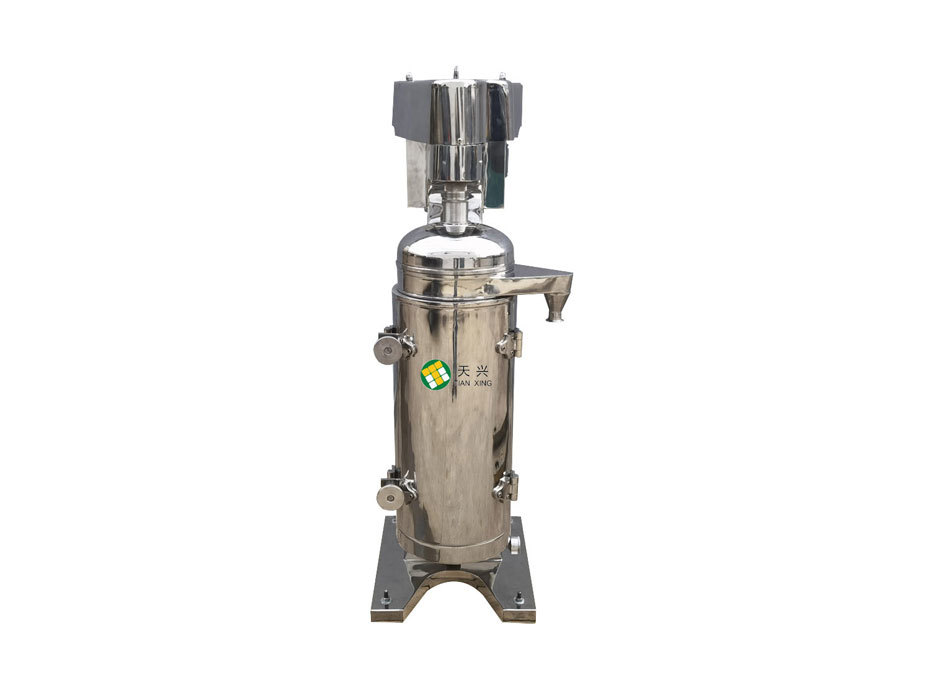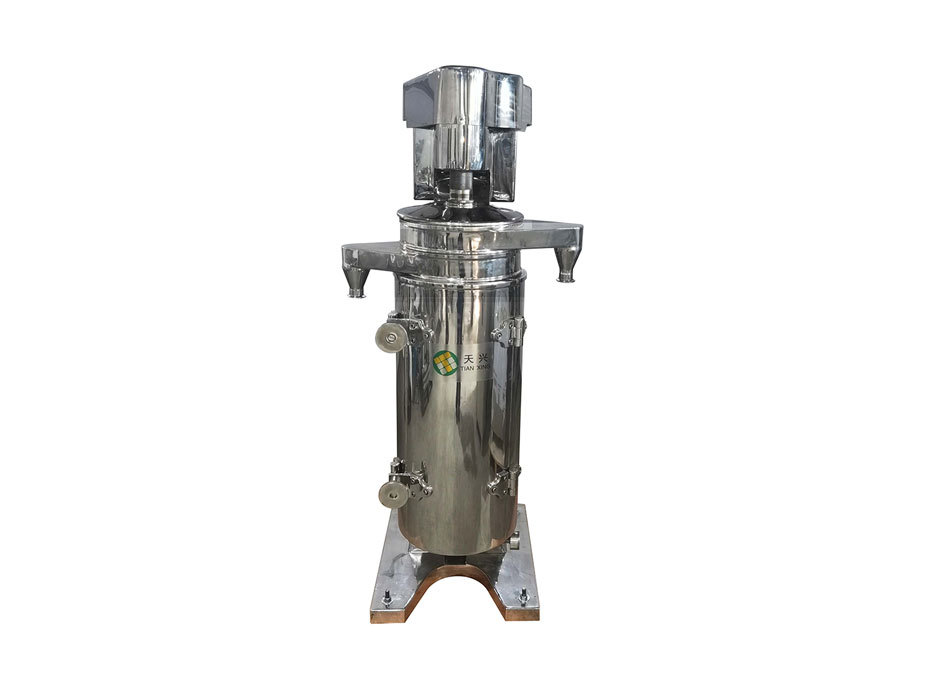
Solid-liquid clarification tubular centrifuge
- Commodity name: Solid-liquid clarification tubular centrifuge
- 产品描述
-
Solid-liquid clarification type tubular centrifuge (GQ type)
The GQ type tubular centrifuge is a device that relies entirely on the difference in specific gravity between solids and liquids for rapid separation under the action of high-speed centrifugal force, without any filtering medium. Due to its high rotational speed and large centrifugal force, it performs exceptionally well in separating materials with small specific gravity differences between liquid and solid, high liquid viscosity, fine solid particle size, and low solid content.
1. Principle
The solid-liquid clarification type tubular centrifuge utilizes the principle of centrifugal force, generating a powerful centrifugal force field through the high-speed rotation of the drum, allowing the liquid and solid phase particles in the mixture to separate according to their density differences. Inside the drum, the liquid is acted upon by centrifugal force, flowing upward along the inner wall of the drum and layering due to density differences. The solid phase particles, being denser, gradually settle at the bottom of the drum, while the clarified liquid flows out from the outlet of the liquid tower, achieving the purpose of solid-liquid separation.
2. Detailed ParametersParameters\Model GQ45 GQ75 GQ105 GQ115 GQ125 GQ150 Drum Inner diameter (mm) 42 75 105 114 125 142 Rotational speed (r/m) 0~28000 19000 16300 16300 15000 14000 Volume (L) 0.36 2.2 6 7 8 10 Separation factor 18440 15200 15620 17000 15700 15580 Nozzle inner diameter (mm) 2, 3 3, 4, 5 4, 6, 8 4, 6, 8 4, 6, 8 6, 7, 8 Feed pressure (Mpa) >0.05 >0.05 >0.05 >0.05 >0.05 >0.05 Maximum water throughput (L/H) 100 600 1200 1300 1500 2500 Motor power (KW) 0.55 1.5 2.2 3 3 3 Weight (KG) 90 260 500 520 530 550 Size (L*W*H) mm 480*460*800 400*760*1120 500*900*1600 500*900*1600 500*900*1600 600*900*1600
3. Application Scenarios
The solid-liquid clarification type tubular centrifuge is particularly suitable for processing the following types of materials:
3.1 Low solid concentration, fine solid particles: For suspensions with fine solid particles and low content, traditional filtration methods are difficult to separate effectively, while the tubular centrifuge can achieve efficient separation through its powerful centrifugal force.
3.2 Small solid-liquid density difference: In materials with small solid-liquid density differences, the enormous centrifugal force generated by the tubular centrifuge can ensure separation effectiveness.
3.3 Multi-field applications: This equipment is widely used in various fields such as plant and animal extraction, traditional Chinese medicine production, food industry, beverage industry, biopharmaceuticals, fine chemicals, and high-tech materials.
4. Operating Steps
The operation of the tubular centrifuge requires strict adherence to procedures to ensure safe and efficient operation. The following are the main operating steps:
4.1 Preparation before operation
4.1.1 Confirm the percentage of solid phase material in the liquid.
4.1.2 Select the appropriate feeding method and nozzle diameter based on the material properties.
4.1.3 Check and adjust the inlet pressure to ensure that the material can fully enter the drum.
4.2 Startup operation
4.2.1 Turn on the motor power and wait for the drum to reach the working speed.
4.2.2 Slowly open the feed valve until the clarified liquid flows out of the collection tray.
Adjust the valve to the predetermined flow rate for continuous separation operation.
4.3 Separation process monitoring
4.3.1 Observe the liquid flow rate and clarity at the outlet to ensure separation effectiveness.
4.3.2 When the liquid at the outlet begins to become turbid, stop the machine in time to prepare for sludge discharge.
4.4 Shutdown and cleaning
4.4.1 Before shutting down, close the feed valve and wait for the collection tray to stop flowing before cutting off the power.
4.4.2 Disassemble the drum, remove internal sediment and solid phase materials, and perform thorough cleaning.
5. Advantages and Disadvantages
5.1 Advantages
5.1.1 Good separation effect: The centrifugal force is 8-24 times that of ordinary centrifuges, capable of separating materials that are difficult to separate with general centrifuges.
5.1.2 Compact structure: The equipment is small in size, occupies less space, and is easy to install and maintain.
5.1.3 Easy operation: Simple operation, no dead angle cleaning, can be disassembled and installed without hoisting equipment.
5.2 Disadvantages
5.2.1 Intermittent operation: Requires regular shutdown to clean the sediment in the drum, affecting continuous production capacity.
5.2.2 High operational requirements: The equipment has high dynamic balance requirements, and the operation process must strictly follow procedures; otherwise, it may cause severe vibrations.
Key words:
Previous Page
online message
* Note: Please be sure to fill in the information accurately and keep the communication unblocked. We will get in touch with you as soon as possible.
Contact Us
Address: Wangjia Village, Wangshuitai Street, Taizihe District, Liaoyang City
Service Hotline:0419-3304406
Mobile: 15809856001
Mobile: 13841969506
E-mail:txzyjx@163.com




